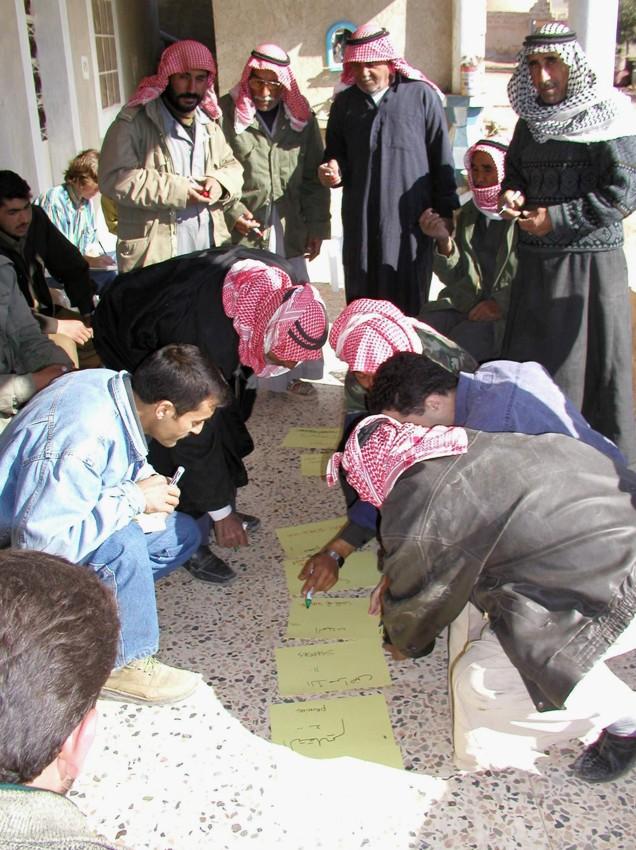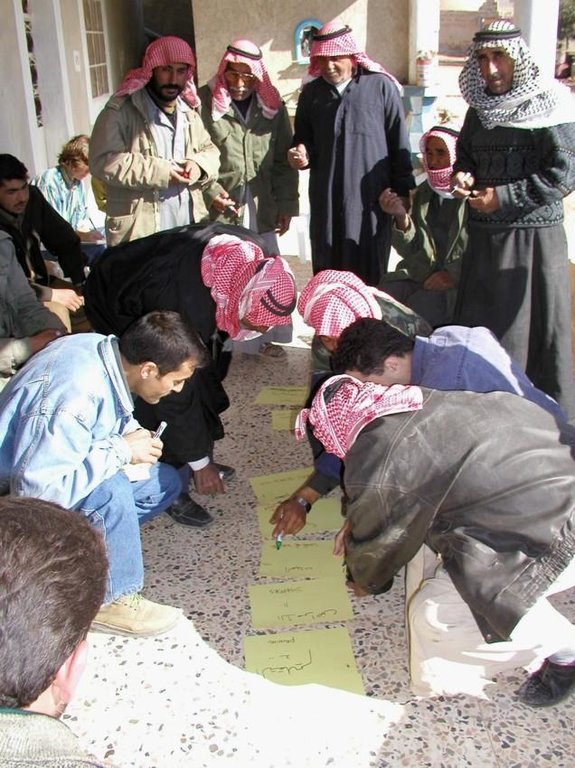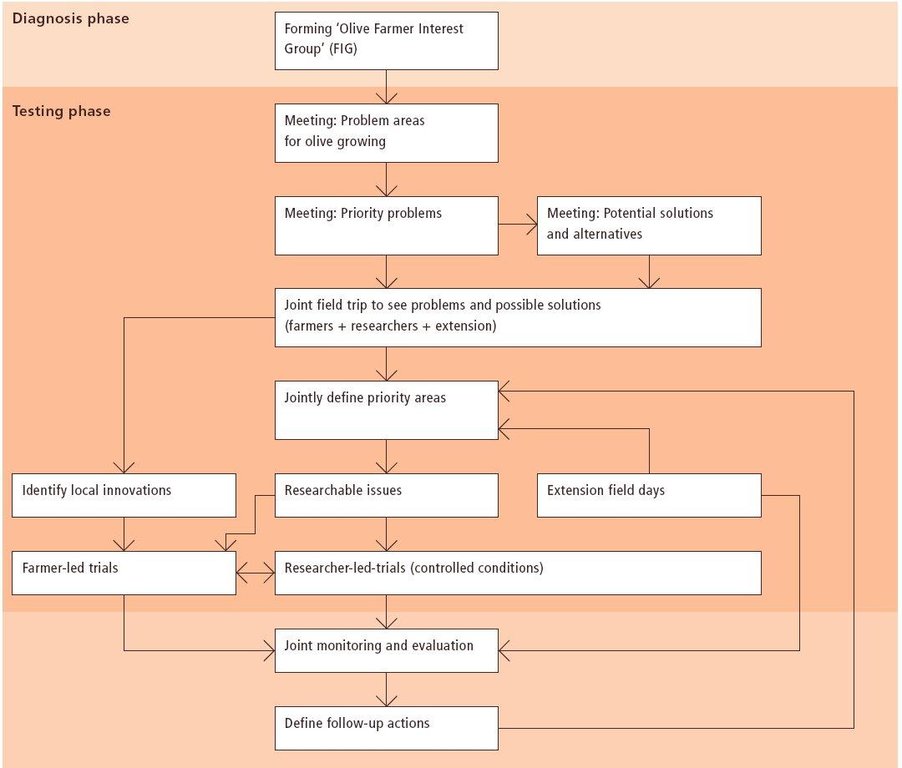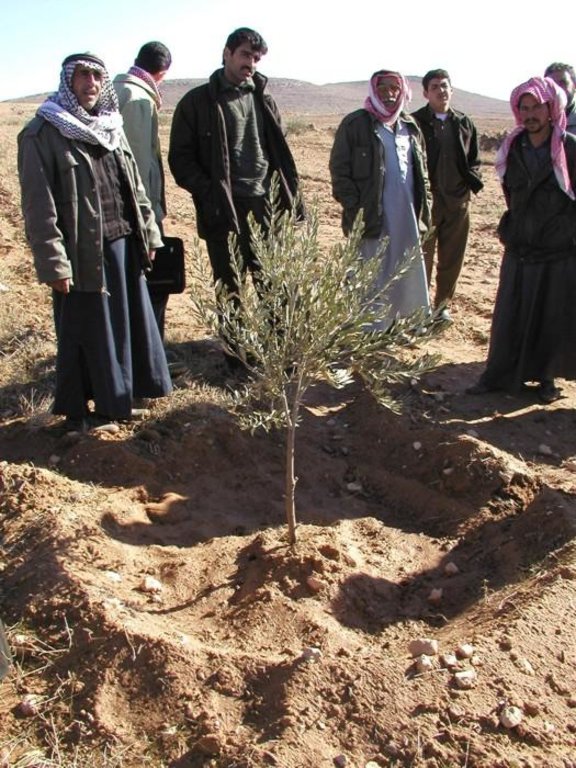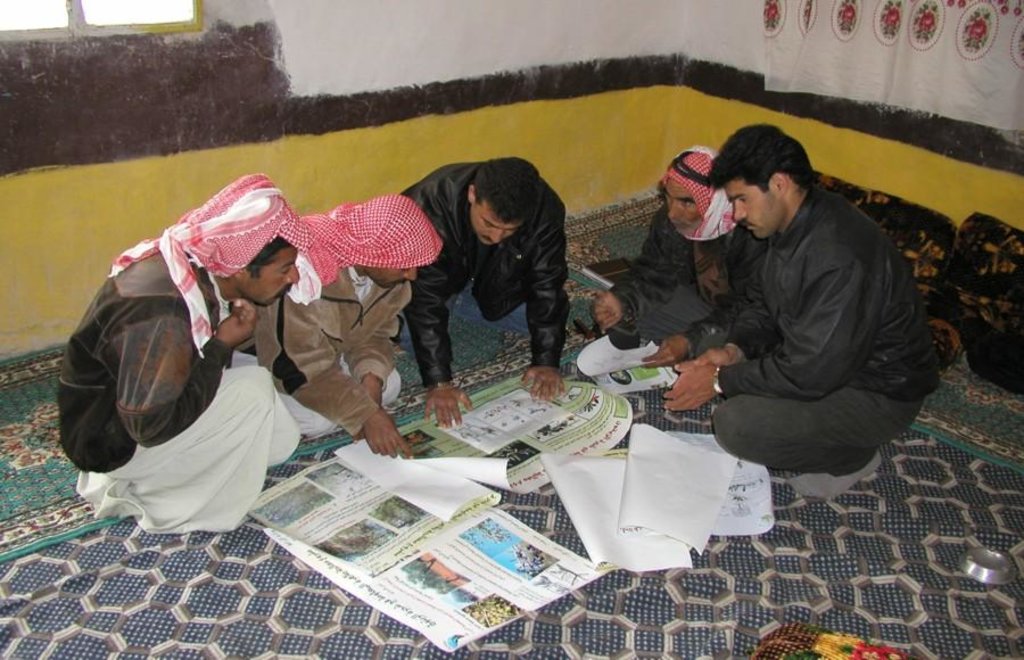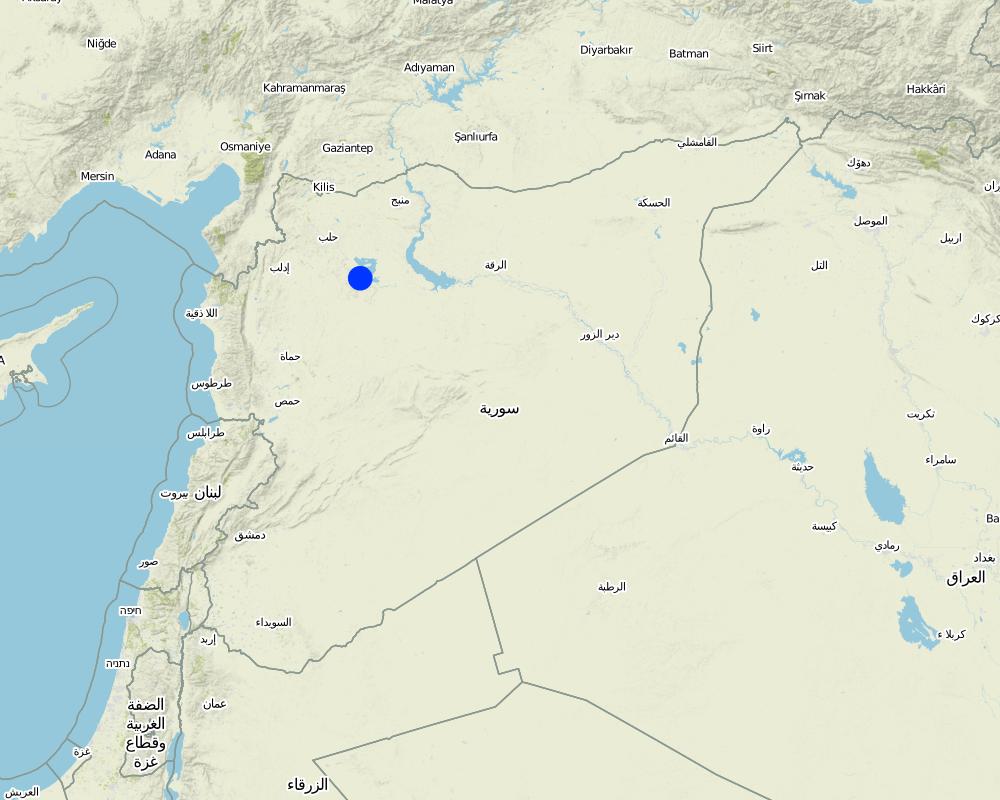Participatory technology development [Syrian Arab Republic]
- Creation:
- Update:
- Compiler: Francis Turkelboom
- Editor: –
- Reviewer: David Streiff
approaches_2631 - Syrian Arab Republic
View sections
Expand all Collapse all1. General information
1.2 Contact details of resource persons and institutions involved in the assessment and documentation of the Approach
SLM specialist:
Tubeileh Ashraf
A.Tubeileh@cgiar.org
Syrian Arab Republic
SLM specialist:
Bruggeman Adriana
The Cyprus Institute (CyI)
Name of the institution(s) which facilitated the documentation/ evaluation of the Approach (if relevant)
The Cyprus Institute (The Cyprus Institute) - Cyprus1.3 Conditions regarding the use of data documented through WOCAT
The compiler and key resource person(s) accept the conditions regarding the use of data documented through WOCAT:
Yes
1.4 Reference(s) to Questionnaire(s) on SLM Technologies
2. Description of the SLM Approach
2.1 Short description of the Approach
Participatory technology development, through close researcher-farmer interaction, for sustainable land management of olive orchards in dry marginal areas.
2.2 Detailed description of the Approach
Detailed description of the Approach:
Aims / objectives: The purpose of participatory technology development is to gain from the synergy between indigenous knowledge and scientific expertise. The specific objective in this case was to develop and test water and land management techniques in order to sustainably improve olive production in a semi-arid area, while ensuring that the techniques were well adapted to local farming practices. The approach consists of group meetings, joint field trips, identification of local innovations, extension days, monitoring of farmer practices, and researcher-controlled experiments. The approach consists of a cycle with three major stages: a diagnostic phase, a testing phase, followed by monitoring and evaluation. In this case study, farmers were invited based on their interest in growing olives. Participation throughout the learning cycle was completely voluntary: no material or financial incentives were used (although they expected them in the beginning of the process). The role of farmers was to identify priority problems and potential solutions, to test new technologies on their farms, and to evaluate their suitability. Farmers observed the research experiment with water harvesting, and then adapted the technology to their needs. As shown, they built V-shaped bunds around their olive trees to capture rainwater runoff, but - contrary to the researchers??? suggestion - they continued to plough the olive orchards, as this is their standard weed control practice. Weeds attract sheep, lead to fires and compete for water with the olives. This simple runoff harvesting system is well adapted to farmers??? objectives, and their modification -the up-and-down slope furrows created through ploughing - actually serves to increase the efficiency of the water harvesting. The system is now being monitored by researchers to assess its technical and economic efficiency.
Methods: Improved farmer-researcher interaction helps farmers learn about a useful basic technique from researchers, while researchers learn in turn about potential improvements to the technology from local innovators. A community facilitator of ICARDA (International Centre for Agricultural Research in Dry Areas) facilitated the group discussions, and the researchers were asked to be open-minded to new approaches while conducting and monitoring field trials. The approach was tested by an interdisciplinary team of ICARDA as part of the ???Khanasser Valley Integrated Research Site???. This project aimed to develop local-adapted options for agriculture in dry marginal areas alongside a generally applicable integrated approach for sustainable land management in these zones.
2.3 Photos of the Approach
2.5 Country/ region/ locations where the Approach has been applied
Country:
Syrian Arab Republic
Region/ State/ Province:
Khanasser Valley
Further specification of location:
NW Syria
Map
×2.7 Type of Approach
- project/ programme based
2.8 Main aims/ objectives of the Approach
- design, test and disseminate alternative technologies adapted to local conditions - strengthen local knowledge of SWC measures - strengthen joint learning by farmers and researchers
The SLM Approach addressed the following problems: The lack of appropriate ways to develop sustainable technologies to remedy loss of runoff water and poor olive growth -in the context of low-input agriculture on gentle undulating land in water scarce areas with an absence of soil conservation measures.
2.9 Conditions enabling or hindering implementation of the Technology/ Technologies applied under the Approach
availability/ access to financial resources and services
- hindering
Water harvesting is considered expensive due to labour cost.
Treatment through the SLM Approach: Identification of a low-cost water harvesting measure, which can be implemented during the off-season. Cost-benefit analysis.
knowledge about SLM, access to technical support
- hindering
Difficulty in tilling the land when water harvesting structures are in place.
Treatment through the SLM Approach: Integrating local innovations into the water harvesting system.
other
- hindering
Uncertainty about appropriate size of micro-catchment area. Uncertainty about the amount of water harvested. Lack of technical expertise for olive crop husbandry in dry areas.
Treatment through the SLM Approach: Researcher-controlled research and carry out farmer field days, desseminate and elaborate extension leaflets as a help.
3. Participation and roles of stakeholders involved
3.1 Stakeholders involved in the Approach and their roles
- local land users/ local communities
Mainly men were involved, as most activities in olive orchards are managed by men. In addition, culturally bound gender segregation in public makes it difficult to organise gender-mixed meetings. Therefore, separate meetings were organised for women. In the case of one household, the de facto partner was a woman who takes most of the orchard-related decisions and does the work herself.
- researchers
3.2 Involvement of local land users/ local communities in the different phases of the Approach
| Involvement of local land users/ local communities | Specify who was involved and describe activities | |
|---|---|---|
| initiation/ motivation | passive | public meetings |
| planning | interactive | public meetings |
| implementation | interactive | completely conducted by land-users |
| monitoring/ evaluation | interactive | interviews/questionnaires, public meetings; |
| Research | interactive | on-farm; farmer experiments and controlled on-farm experiments |
3.3 Flow chart (if available)
3.4 Decision-making on the selection of SLM Technology/ Technologies
Specify who decided on the selection of the Technology/ Technologies to be implemented:
- mainly land users, supported by SLM specialists
Explain:
Decisions on the method of implementing the SLM Technology were made by mainly by land users supported by SLM specialists
4. Technical support, capacity building, and knowledge management
4.1 Capacity building/ training
Was training provided to land users/ other stakeholders?
Yes
Form of training:
- on-the-job
- farmer-to-farmer
- public meetings
Subjects covered:
Demand-driven training of olive husbandry techniques (eg pruning, grafting, pest management)
4.2 Advisory service
Do land users have access to an advisory service?
Yes
Specify whether advisory service is provided:
- on land users' fields
Describe/ comments:
Farmer-to-farmer extension; Key elements: innovative farmers showed their technique to other olive farmers during farm visits
4.3 Institution strengthening (organizational development)
Have institutions been established or strengthened through the Approach?
- no
4.4 Monitoring and evaluation
Is monitoring and evaluation part of the Approach?
Yes
Comments:
bio-physical aspects were regular monitored by 0 through observations; indicators: soil moisture
bio-physical aspects were regular monitored by 0 through measurements; indicators: water harvesting structures and management measures
technical aspects were regular monitored by None through observations; indicators: perceptions of the technology
socio-cultural aspects were ad hoc monitored by None through measurements; indicators: cost and benefits
economic / production aspects were ad hoc monitored by None through measurements; indicators: annual field survey using GPS
area treated aspects were regular monitored by None through measurements; indicators: annual farmer interview
no. of land users involved aspects were regular monitored by None through observations; indicators: None
There were few changes in the Approach as a result of monitoring and evaluation: There were few changes: interest in the farmers??? orchards and questions about the technology stimulated some other farmers to apply water harvesting.
4.5 Research
Was research part of the Approach?
Yes
Specify topics:
- sociology
- economics / marketing
- technology
Give further details and indicate who did the research:
Research was an important part of this approach. Technical and socio-economic topics were treated as follows: (1) Researcher-controlled on-farm experiments: this helped evaluate the impact of water harvesting design on the amount of water harvested and the olive crop response. (2) Monitoring of farmer-managed trials: to evaluate the performance of water harvesting under on-farm conditions. (3) Cos
5. Financing and external material support
5.1 Annual budget for the SLM component of the Approach
Comments (e.g. main sources of funding/ major donors):
Approach costs were met by the following donors: government (national - ICARDA, Atomic Energy Commission Syria): 10.0%; international non-government (BMZ (Germany)): 50.0%; local community / land user(s) (-): 40.0%
5.2 Financial/ material support provided to land users
Did land users receive financial/ material support for implementing the Technology/ Technologies?
Yes
5.3 Subsidies for specific inputs (including labour)
If labour by land users was a substantial input, was it:
- voluntary
5.4 Credit
Was credit provided under the Approach for SLM activities?
No
6. Impact analysis and concluding statements
6.1 Impacts of the Approach
Did the Approach help land users to implement and maintain SLM Technologies?
- No
- Yes, little
- Yes, moderately
- Yes, greatly
Adoption of the furrow-enhanced runoff-water harvesting technique resulted in a concentration of scarce rainwater and nutrients in the basins around the olive trees. The consequence is a significant reduction of soil loss and runoff at the field level.
Did other land users / projects adopt the Approach?
- No
- Yes, little
- Yes, moderately
- Yes, greatly
This approach is now being applied in other ICARDA-coordinated projects in the region.
6.3 Sustainability of Approach activities
Can the land users sustain what has been implemented through the Approach (without external support)?
- yes
If yes, describe how:
The complete PTD process/learning cycle needs outsider facilitation, but lack of outsiders will not stop farmers experimenting further by themselves. In terms of the technology itself, farmers can continue independently with water harvesting structures, as the system is very simple and relatively cheap.
6.4 Strengths/ advantages of the Approach
| Strengths/ advantages/ opportunities in the compiler’s or other key resource person’s view |
|---|
| Engagement of researchers with local innovators and thus interaction between scientific and indigenous knowledge (How to sustain/ enhance this strength: This approach can only be sustained if it is mainstreamed into national research and extension services.) |
| Attitude changes by researchers about farmers??? knowledge (How to sustain/ enhance this strength: Ditto.) |
| Building on local knowledge (How to sustain/ enhance this strength: Ditto.) |
| Capacity building of both land users and researchers (How to sustain/ enhance this strength: Ditto.) |
| Demand-driven technologies (How to sustain/ enhance this strength: Ditto.) |
6.5 Weaknesses/ disadvantages of the Approach and ways of overcoming them
| Weaknesses/ disadvantages/ risks in the compiler’s or other key resource person’s view | How can they be overcome? |
|---|---|
| Time demanding | Less time needed after the first experience. |
| Appropriate facilitating skills required | Mainstreaming facilitation skills. |
7. References and links
7.1 Methods/ sources of information
- field visits, field surveys
- interviews with land users
7.2 References to available publications
Title, author, year, ISBN:
Tubeileh A and Turkelboom F (2004) Participatory research on water and soil management with olive growers in the Khanasservan Veldhuizen L, Waters-Bayer A, Abd de Zeeuw H (1997) Developing technology with farmers:
Links and modules
Expand all Collapse allLinks
No links
Modules
No modules


